Vermont’s New Face of Fitness: The Mirnavator
Mirna Valerio is changing the definition of what it looks like to be a successful athlete.
By Sophie Hiland
One of Vermont’s most recognized professional athletes sits on the steps of the state capital on an otherwise gray day in July. Her laugh echoes between the fluted white granite columns of the statehouse as she talks about some of the 25 marathons and ultras she’s completed, including the 6-day TransRockies, running with the Tarahumara in Mexico, the Los Angeles Marathon (her last race before Covid-19 hit) and what got her to this place.
She smiles wide when she talks about what influenced her decision to come to Montpelier in December 2018. Mirna had just moved from Georgia to Brooklyn, where she grew up. She drove up to Vermont from Brooklyn to visit a friend and spent a week snowshoeing, skiing and adventuring.
“When I made the turn off Memorial Drive and drove down Main Street, I saw two banners,” Mirna’s smile gets wider and her eyes light up. “One was a Black Lives Matter banner, the other was a Pride flag. I thought “Okayyyy. I can live here. This isn’t Georgia.”
“This place” is both the physical place — Montpelier, Vermont — and this place in her career. Mirna is able to finally quit her job as a teacher and devote herself to training for ultramarathons and, now, cycling and other sports.
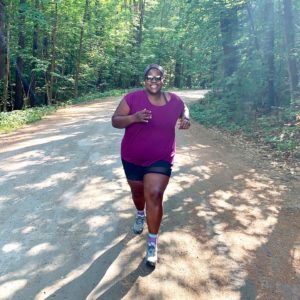 And if that is not enough, she has an Instagram feed with 108,000 followers to maintain, a blog, a second book to write and sponsors such as Merrell, L.L. Bean, and new this week, an upcoming sponsorship with a brand that is adding plus sizes, to promote. “Heck, I made a quarter of my old annual salary doing a 7-hour photo shoot for JC Penney,” she says with a laugh.
And if that is not enough, she has an Instagram feed with 108,000 followers to maintain, a blog, a second book to write and sponsors such as Merrell, L.L. Bean, and new this week, an upcoming sponsorship with a brand that is adding plus sizes, to promote. “Heck, I made a quarter of my old annual salary doing a 7-hour photo shoot for JC Penney,” she says with a laugh.
Mirna also happens to be a Juilliard- trained opera singer, a former Spanish teacher, director of Diversity, Equity and Inclusion for 18 years, a mother, a social media influencer, a writer and speaker, the subject of multiple short films, and now, a Montpelier resident.
In many ways, she’s much like any one of Vermont’s elite athletes—people such as mountain biker Lea Davison, runner Elle Purrier and cyclists Ted King and Ian Boswell.
Except for this: Mirna Valerio is big, she is Black and she has never won a race.
That has not stopped Mirna, 44, from becoming one of the most recognized athletes of the decade. In naming her one of their eight Adventurers of the Year in 2018, National Geographic described Mirna as an “unwavering spirit.” The woman who nominated Mirna for the distinction, Jenny Nichols, co-creator of the film “The Mirnavator” , told National Geographic that “Mirna is the definition of a trailblazer. She is redefining what a runner looks like and she’s doing it with style, grace and a huge smile.”
AN UNLIKELY PATH

What got Mirna Valerio here? How did someone who started off her fitness “journey” (she uses the word with air quotes, adding “I hate that word, as it always implies weight loss”) in 2009 by posting her workouts on Facebook, become an athlete with sponsors such as Merrell, Leki and L.L. Bean?
As a child growing up in a family that oscillated between poor and working class in the Bushwick section of Brooklyn, Mirna could always be found
with her head in books that her stepfather brought home from the hospital where he worked in the laundry. That eagerness to learn earned her a scholarship to a prestigious private boarding school in Westchester, N.Y., the Master’s School. As a freshman there, she decided to join the field hockey team.
Before joining the team, Mirna had never jogged laps around a field. None of her role models or family members exercised. You wouldn’t find joggers running on the concrete sidewalks that crisscrossed her neighborhood.
As Mirna worked hard to complete a couple of laps around the field, she found that she felt proud after each lap. She loved working be a better teammate, and while she wasn’t the most skilled player, she loved the team environment and spirit.
She went on to Oberlin College to study music and Spanish. After college, she worked first for KPMG and then taught Spanish at the Master’s School, her alma mater. Mirna would return to running sporadically, though her busy schedule often kept her from sticking with a routine for longer than a couple of weeks.
Then, after another move, Mirna’s fitness routine fell off. By the time Mirna was 33 she weighed more than 300 pounds. In 2008, she was living in New Jersey and was teaching Spanish at a boarding school when she experienced a health scare. While the chest pain she experienced was diagnosed as a panic attack, doctors explained that she was a prime candidate for a serious cardiac event.
“I got back on the treadmill after a three-year hiatus from doing anything sustained, fitness-wise,” she recalled. She convinced a co-worker to start jogging with her and, slowly but steadily, she and her running partner worked their way from 5Ks to longer races. Friends and family showed her incredible support, and Mirna was pleasantly surprised to see that her Facebook friends were also cheering her on, big time.
Mirna explains that posting on Facebook played a huge role in holding her accountable to her goals. “I would post all my workouts on Facebook,” she said. The posts read: “I ran five miles” and “I swam for an hour” and “I signed up for three 5Ks this week.” Looking back on those posts, Mirna rolls her eyes and laughs at herself. “I must have driven everyone crazy! There were just so many posts, sometimes I would post three times a day.”
She became something of a fitness evangelist, recruiting friends and co- workers to join her in the weight room or for a morning jog. Soon, they began calling her “Vator,” short for “Motivator.” Eventually, “Vator” and “Mirna” were combined to make “Mirnavator.” The name stuck. “I was like, ‘I kind of like that name’ so I changed my Twitter handle to ‘Mirnavator,’” she says with a grin.
By 2009, Mirna wasn’t just going for a couple of jogs a week, she was constantly running. “All I did was run. I was running in the morning and in the afternoon and I would sneak away during the day and go to my apartment and run on my treadmill.”
All this running had a positive impact on Mirna’s mental health, not just her physical health, though that was improving, too.
“Running was kind of getting me back to myself again,” she says, almost wistfully, as she looks out across the state house lawn. (A patella injury has kept her from running recently and Covid-19 has cancelled nearly all the races on her current calendar.)
Soon the Purnell School asked her to be a running coach. “At the end of our first season, after three months of training, I got the girls to run nine miles. We waited for the last girl to finish and then went right into dinner as a team because it was a boarding school.” With a look of pride on her face, Mirna says: “When we walked in, everybody stood up for us. Nine miles is a lot, especially if you have never run previously.”
Coaching cross country allowed Mirna to, as she says, “teach students how to make running a part of their lifestyle.” She adds, “It also highlighted how important running was, not just to me but to other people and how it could change their lives.”
Mirna began thinking about more ways to share her advice and motivate others, especially people who didn’t feel welcomed by the sport. In 2011, Mirna started Fat Girl Running, a blog where she encouraged other “big women runners,” posted workouts and made gear recommendations.
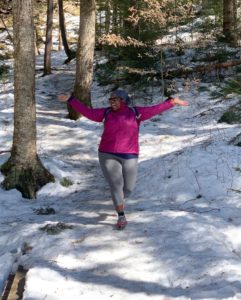
Over three years Mirna lost 70 pounds, but losing weight wasn’t her primary goal. She was working on strengthening her cardio and improving her all-around fitness. In early 2015, she was interviewed by Rachel Bachman, who was writing an article for The Wall Street Journal. Bachman’s article “Weight Loss or Not, Exercise Yields Benefits” was triggered by a study showing the significant health benefits to overweight and obese people of being physically active—even if they don’t lose a pound.
Mirna told Bachman: “People have said to me, ‘I don’t understand why you’re not thinner’… (And I reply) the last time I was thin was second grade. I am who I am.”
“When The Wall Street Journal article came out,” Mirna continued, “I heard from everyone and I thought oh, this is cute,” she said as she giggles and flashes her infectious smile. But she also received negative feedback, comments like “you’re too fat to run” or “you probably don’t run anyway.” The comments didn’t stop.
In the 2017 REI-sponsored film, The Mirnavator, Mirna reads an email on her phone as she does the last lap of an ultra. It read: “You are a liar and a fraud… A true professional runner is not overweight, which is what you are. A person who runs marathons for a living is not overweight, which you are.”
The email suggested that Mirna didn’t actually run, but instead “pretends to (run)… You expect people to be stupid enough to actually believe this sh*t… I have seen your few videos where you actually pretend to run. What a joke!”
Mirna winces even as she remembers this. But her running cred was already solidified. In July 2015, Runner’s World ran a 12-page story on her by John Brant. “It was amazing. Here I was in a major running magazine, in all my fatness. All my slowness. I was being recognized for what I did,” Mirna said.
Since then Mirna has gained 108,000 followers on Instagram, has been profiled by many major media outlets, and has heard from thousands of fellow fat people and people of color who have been inspired by her. She explains that a lot of them have seen her and said: “if Mirna can do it, I can do it too.”
Mirna readily acknowledges her unique place in the sports world. “I get noticed because I am an anomaly,” she says. Many fat runners are presumed to be running in order to lose weight, to change their physical appearance,” she added, but she is quick to explain that for her “running has been an expression of love. Love for my physical body, my mental body, my emotional body and my spiritual body.”
Mirna has also been using her platform to combat the overwhelmingly common representations of long- distance runners and outdoors athletes in the media as white and thin. “When you don’t see yourself represented in the outdoor and athletic media, you don’t think you belong there.”
Mirna points out that the images of runners you see so often in ads and magazines are not all-inclusive. “If you ever look at who is running a marathon,
or any race, you’ll see a broad spectrum of humanity.” This diversity does exist, she points out. “Even nowadays, when you think of trail runners, you don’t think of somebody that looks like me.”
In 2017, Mirna published her own story, a memoir titled A Beautiful Work in Progress. In it she writes about how she is fat shamed, expected to hide her body, told she is not a runner and is assumed to be unhealthy and unmotivated. In the book she says, “But that’s all wrong. I have a body that is amazing and strong. It’s flexible and agile. It can carry me across one hundred kilometers and up and down mountains. It has birthed a baby and survived fractures, breaks, and multiple bouts of pneumonia.”
GOING THE DISTANCE
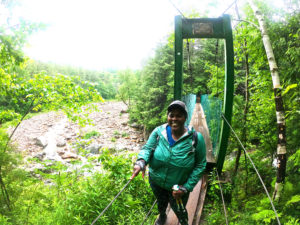
Mirna is the kind of runner who hits her stride deep into her run, once she reaches double digit mileage. This makes trail running perfect for her. Long mileage, beautiful scenery and a can-do attitude are all hallmarks of this increasingly popular subset of running, and Mirna fits the mold.
“Trail running,” Mirna says, “is just something I love doing.” She takes a second to figure out how to explain the allure. “No matter what, I’m going to be outside, literally all day, and this is a way that I can do that.” Another huge draw is that trail running allows her to see “a little bit more than I would if I were hiking.” A wide grin sneaks across her face. “But not much more, because I’m slow,” she chuckles, “but a little bit more.”
Over the years, Mirna began to gravitate towards longer races, progressing from 10Ks to half marathons and then full marathons and ultras.
“In 2012, at the end of my first trail marathon, Rick McNulty who was the director of the New Jersey Trail Series sees me at the finish. He doesn’t say ‘congratulations’ or ‘well done’ or ‘good job,’” she laughs. “He goes ‘50K next year?’”
Mirna’s face freezes as she imitates the look of shock and confusion that she had after hearing this. But following that race, she recalls, “I started doing 50Ks.”
In 2015, the summer she was featured in Runner’s World, Mirna came to Vermont to do the Catamount Ultra on the trails of the Trapp Family Lodge in Stowe, one of the five Ultras, of lengths varying from 25K to Arizona’s 100-K Javelina Jundred, she would run between June and October that year.
“That first year my mom drove up with me for the race. We arrived on a chilly June night and we had the most gorgeous sunset,” she remembers. Mirna describes the energy of that first race, as well as the subsequent ones, as full of “really competitive people, who come together in a way that is very chill. I love that atmosphere.”
After going “up and up and up for seven and a half miles in mud,” Mirna decided to do the 25K, instead of the 50K that first year. “I could have gone on, but I just wanted to hang out,” Mirna recalls, adding with a smile “and the beer and pizza after were great.”
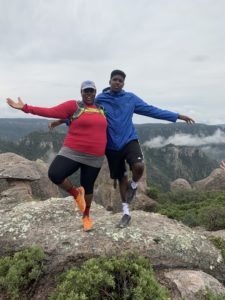
She returned to run the Catamount Ultra in 2016 and in 2017. Then, in December 2018 she came up to visit a friend in Barre. They snowshoed up Mt. Hunger, which Mirna describes as “not the prettiest mountain or the prettiest trail, but I just love it.”
“By the end of the week,” she continued, “I had discovered that the Montpelier Inn, where I had been staying, had furnished apartments for rent.” Mirna’s son was in boarding school and Cito Nikiema, her husband of 20 years was traveling a lot for work. Mirna didn’t have a job tethering her to any place. “I thought, ‘let me try this’, and I moved in the next month.”
It’s not just the physical landscape that got Mirna excited about moving to Vermont. “I was really seeking engagement with local politics.”
Progressive politics aren’t the only reason Mirna moved here. “Community is the expected norm here,” she said, adding that the small city allows her 17-year-old son, Rashid, to walk downtown to play basketball or grab something from Shaw’s. “I love the freedom he has here,” she said, noting that she is currently working on a second book about how to raise your child in the outdoors. She is using her own experience raising Rashid in rural Georgia and Vermont, as well as her 18 years as a teacher and coach as her source of expertise.
One of Rashid’s and Mirna’s most memorable adventures took place in October 2019 in Mexico’s Copper Canyon where Mirna co-hosted a running retreat with some Tarahumara natives who are noted long-distance runners. Runners were grouped in staggered starts for an 8-mile point-to-point trail run based on their paces. Rashid set off ahead of her.
When the time came to regroup midway, he was nowhere to be found.
“This is in the Copper Canyon of Mexico and things happen there…” Mirna says, her voice trailing off. A search party went out. Her heart raced. The town’s mayor even showed up. “Then I found Silvino, one of the Tarahumara, who asked me what shoes Rashid was wearing. We managed to track Rashid’s footprints as we both wear Merrells,” Mirna recalled. Rashid it turns out, had run ahead, completing the course. “He was where he should have been— on the right path the whole time.”
Mirna’s face beams with pride as she says, “I’d taught him to run trails, to follow blazes and he knew his stuff. We are always so worried about how our kids are going to turn out, but as long as we provide an environment that is safe and allows them to explore a little bit, they’ll be ok.”
Mirna’s mother might say the same thing about her.

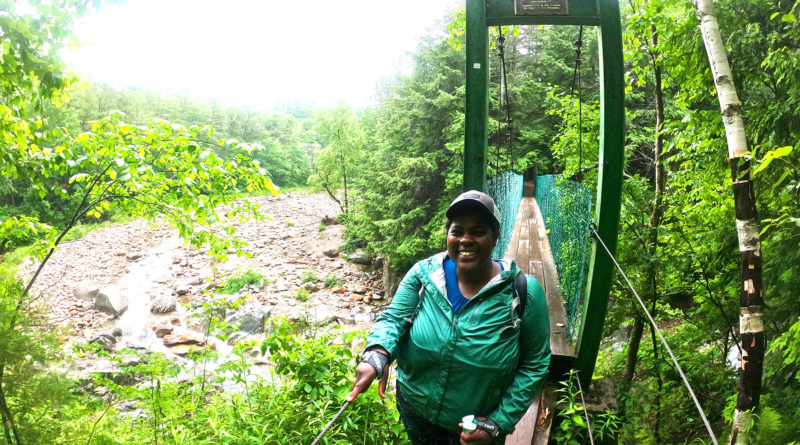


I really enjoy this gorgeous woman and all she is accomplishing. More Power to Her!